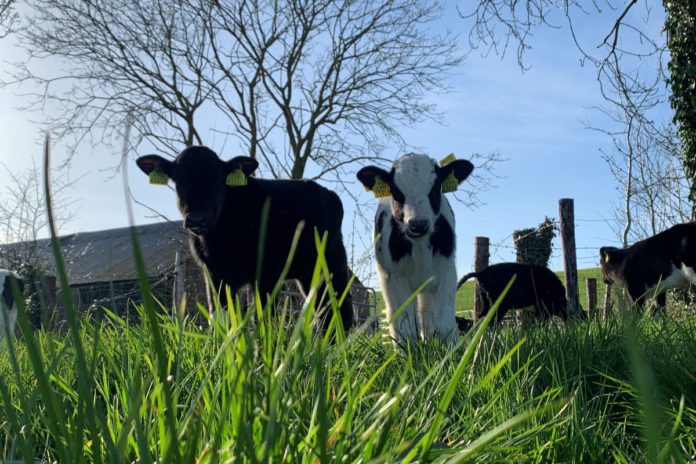Setting up your farm for calf-rearing
In this article, That’s Farming, looks at setting up a farm to rear calves. We discuss the appropriate temperature for housing, hygiene requirements, draughts and ventilation, dryness of the calf shed and finally, designing pens.
To enhance calf performance and minimise the incidence and spread of disease, setting up your farm correctly to rear calves is vital.
When aiming to produce a strong, well-grown and thriving calf, housing, general husbandry, and health management of calves are paramount to continue development.
A range of housing layouts will influence and drive a calf to thrive. When establishing a shed set-up for successful calf rearing, several factors should be considered, whether it is your first time or not.
Temperature of housing
A vital aspect of a calf’s housing requirement is the shed’s temperature. During the winter in Ireland, it can be difficult to maintain the optimal air temperature for calves, which is 15 to 20 degrees Celsius.
The introduction of calf jackets can enhance the air temperature endured by the calves should temperatures drop below the optimal.
If you introduce calf jackets to your farm, please ensure they you appropriate washed between each calf use. This will also reduce the occurrence of the spread of disease.
The use of heaters provides a benefit to calves in the instance of colder periods of weather. This is especially the case for sick calves, whereby infrared bulbs or quartz liner heaters are used.
Consider hygiene
Deep cleaning with steam aids biofilm removal on areas such as gates and troughs. These areas can host infectious bacteria for up to 30 days.
In terms of both hygiene and general calf welfare, calves should have 24/7 access to clean water. The incorporation of drinking water, alongside milk, influences the development of the rumen.
Another aspect of hygiene to consider is isolating sick calves. This will also control the spread of some common outbreaks such as scour. Once sick calves are well enough to be re-introduced to the rest of the calves, ensure you adequately clean the sick pen.
When setting up your farm for calf rearing, hygiene is at the forefront of success. Young calves are susceptible as their immunity is not yet fully developed, which should be kept in mind.
Consider cleaning out calf pens between batches. Furthermore, ensure you replace and clean teat feeders as required and clean buckets and troughs between feeds.
When bedding with straw, it is best to replenish daily. The first three months of a calf’s life are particularly vital for its future health and performance.
Avoid draughts
Ventilation is key for calf thrive, but ensure that draughts are closed off throughout the calf housing facilities.
Allowing adequate ventilation will reduce the occurrence of stale air, which will also aid in the prevention of disease within your calf shed.
Moreover, there are a few points to consider in terms of appropriate ventilation, such as:
- The side of the air inlets: these should be two to four times bigger than the outlet;
- Mechanical ventilation: this is whereby fresh air is generated through plastic tubes in ventilation holes;
- Minimum air outlet: outlets should be located on the roof ridge, and areas of the centre of the shed such as chimneys can also be used. Better ventilation arises from a higher pitch;
The identification of condensation within the roofing of the shed is a key sign of poor ventilation within your calf shed.
The opening of doors for ventilation incurs a draught throughout the shed. In the instance that this is your only source of ventilation, consider cladding the top half of the door with a ventilated sheet.
Drains and dryness
When producing calves, there is a considerable amount of liquid produced and handled within the calf handling facilities.
Pathogens that exist in calf housing facilities generally best survive in damp conditions. Hereafter, promoting dryness is a significant target.
Dampness within the calf shed will also make air temperatures feel colder than they are, further creating problems for the health of your calves.
Where there are floors which do not drain adequately will require intervention from the farmer through a number of mechanisms. An option in this area would be to introduce sawdust where there is liquid lying in the hollows of the floor.
When considering a more long-term solution, consider casting a new concrete floor with incorporated slopes and gutters.
Aim to house your calves on a dry bed, with all exposed floors being dry, too.
Consider pen design
When designing pens, consider visual contact between calves in an area which is also easy to maintain and clean.
Plastic pens for single calves are simple in design, and you can remove them for power washing. Pen floors ideally will have a slope to allow for effective drainage after cleaning.
Drain channels set in the floor can be used for the collection of urine/dirty water from the front of the pens and will also keep the passage floors clean and dry.
Furthermore, there are benefits to penning calves in groups regarding labour efficiency. However, this does increase the risk of pathogen spread. Should you consider group pens for young calves, the requirement for competent hygiene is detrimental.
In the instance that calves are suited to be penned individually, the area for a calf from birth to 8 weeks of age should be at least 1.5m2. The width of the pen must be equal to the height of the calf at the withers.
The environment in which you choose to rear calves on your farm impacts the risk of calf mortality and significant health issues, as well as the potential lifetime performance.
Other articles published by That’s Farming this week:





